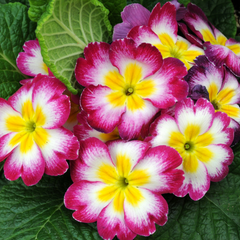The bright blooms of spring flowers can’t come soon enough after a particularly long, quarantined winter. While some brave flowers pop their heads up during winter, the real show begins in the cool, sun-soaked days of March and April. That’s when we get to see the fruits of our fall labors, as many spring flowers burst forth from bulbs planted in cooler months.
Let’s take a look at the variety of spring flowers that are just waiting to come to life in your garden. Whether you choose to replant annuals each season or perennials that will come back again and again, a bit of planning and a good day’s work will be worth the effort come springtime.
Spring flowers and how to plant them
Tulip

A classic symbol of spring, tulips come in many colors and shapes, all equally delightful to see bloom in the spring. While they’re technically annuals, the second year’s bloom can be a bit lacking, so most gardeners opt to plant bulbs anew each fall. If rodents are an issue in your garden, try planting tulips in pots or layered with other bulbs (like daffodils) so your tulip bulbs are less likely to become a tasty treat while they wait for spring.
Plant in full sun. Thrive in USDA Hardiness Zones 3 to 7.
Daffodil

These spring classics are best known for their curious bright yellow flowers, although they do appear in pink, white, and two-tone color combinations. Their bulbs – which must be planted in fall – are hardy, so you won’t have to worry much about foraging wildlife as you wait for spring to come. Plant daffodil bulbs in clusters for the most dazzling effect come spring.
Plant in full sun. Does best in Zones 4 to 8.
TIP: Need some guidance for your bulb planting? Check out our blog post on planting bulbs in fall.
Primrose

The unassuming primrose can offer quite the delight in your spring garden. Cross-pollination of multiple colors can result in surprising combinations of pink, purple, and yellow the following season. They’re low maintenance and prone to self-sow throughout your garden, as long as they get regular watering during the warmer spring months. There are hundreds of varieties, so be careful to select one that will thrive best in your growing zones.
Plant in part to full shade. Most varieties best suited for Zones 3 to 8.
Iris

Dwarf iris is an early bloomer, shooting fragrant purple blooms and dark green grass out of the ground at the first sign of spring. Other species have similar dramatic form. Plant your irises close to the surface (about 3 inches deep) and expect them to multiply and come back year over year.
Plant in full sun to part shade with good drainage. Best for Zones 5 to 9.
Columbine

The deceptively delicate looking columbine can hold up to sporadic spring weather. Their bright purple, pink, yellow, red, or white flowers bloom from April to May and are sure to make pollinators (including hummingbirds) happy.
Plant in full sun to part shade with well-draining soil. Best in Zones 3 to 9.
Crocus

These sweet little flowers appear in early spring, with some even pushing through the snow-covered ground. They’re equally delicious to rodents as they are beautiful to us, so layering their bulbs under less-tasty daffodils can help outsmart hungry chipmunks and give your crocus a chance to see the light of spring.
Plant in full sun with rich soil and good drainage. Suited for Zones 3 to 8.
Sweet Pea

Don’t be fooled by its name, the sweet pea is for viewing, not eating. Their fragrant flowers bloom from spring to early summer and will grow tall into the sun, reaching heights of up to 8 feet. To give them their best shot at blooming, start them from seed indoors to give them a head start in cooler weather. Then plant near a supportive fence or trellis and watch them climb!
Plant in full sun. Zones 2-11.
Snapdragon

The stunning snapdragon will alight your garden with blooms of all shades, from pastel pink to deep purple hues. They’re hardier than they look and don’t mind a light frost, so they make for a great choice in your spring garden.
Plant in full sun to part shade. Zones 6 to 10.
Lupine

These gorgeous perennials boast tall, colorful flowers that butterflies will love. They’ll add dimension and texture to your garden, with their tall height making for wonderful border planting. Deadhead your plant to encourage additional blooming and keep the pollinators coming all season long.
Plant in full sun. Zones 4 to 8.
Pansy

As soon as your soil is soft enough to dig into, start planting pansies! They come in a wide variety of colors and patterns, all of which are sure to put a smile on your face from April to June. They do well in hanging baskets or pots, so go wild and spruce up your small spaces with a pop of pansies.
Plant in full sun to part shade. Zones 6 to 10.
What you need to get started
The right tools will make your spring gardening all the more enjoyable. You’ll need:
- A handheld rake that’s gentle enough to remove leaves and other debris without harming your blooms
- A handheld shovel and planter for loosening and furrowing the soil
- A long-handled bulb planter for hollowing out the perfect holes for your spring bulbs
- A kneeler and seat for careful, yet comfortable, garden tending
Grab your gloves and get planting! Now that you’ve got the basics, get out and enjoy the color, fragrance, and birdsong of spring. There’s truly nothing better than a spring garden after a long winter.






